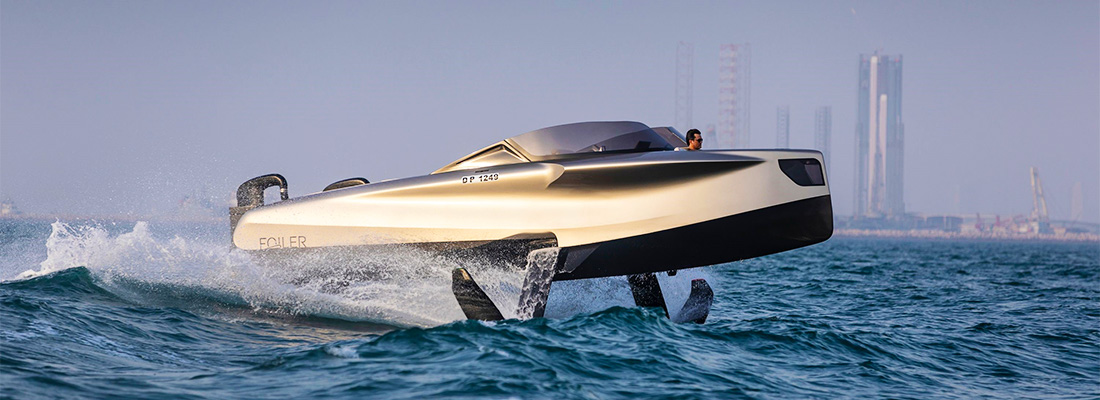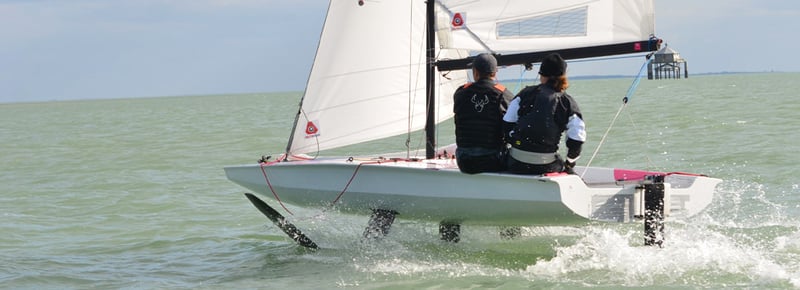How far can foiling technology in boats go?
 Peter Franklin
Peter Franklin
As a person who started out working and living around boats many decades ago, I sometimes take a few minutes to reflect on how dramatically things have changed during that time. I also wonder how much further technology and inventive creativity can push the boundaries, and to keep producing boat design concepts that we could only dream of a few years back.
Reflecting back into the ‘not so’ distant past, I was privileged to be on the press boat following the 32nd America’s Cup held in Valencia back in 2007. That contest was the last of the AC monohull duels, where the competing Alinghi and BMW Oracle boats were fairly evenly matched, leading to some really thrilling finishes that were very exciting to be up close to.
How the sailing world started embracing foiling technology
Fast forward to 2010, and there I was, again bobbing around on the press launch off Valencia, waiting for the 33rd America’s Cup to take place, after 3 years of legal wrangling about the race format and design technicalities. This time, the boats bore no resemblance at all to the ones used in 2007. The BMW Oracle carbon fibre Trimaran rigged with a massive revolutionary wing sail, and given a huge lift with hydraulically operated dagger boards, showed a clean pair of heels to the Alinghi catamaran in some shifty wind conditions. No contest really, and no heart stopping finish for spectators to enjoy, but a big leap forward in technology for sure, which arguably changed the whole perspective of America’s Cup racing forever.
Just prior to this in 2009, anyone with even the slightest interest in sailing, was being enthralled by the news of French skipper Alain Thébault and his crew, breaking the world sailing speed record record. Over 500 metres they achieved an average speed of 51.36 knots with their foiling trimaran named l’Hydroptère. They also managed to break the speed record over one nautical mile, increasing it from 43.09 knots to 48.72 knots.
Foiling fun, opening up to the masses
Fast forward again, to the 2017 35th Americas Cup in Bermuda, where regretfully, I was not in attendance this time. By then, the dagger board ‘lifting’ principle had been transformed into a fully foiling design, a concept which literally flies the entire catamaran above the water, reaching downwind speeds of up to 50 knots. And it seems from there onwards, the hydrofoil sailing revolution was well and truly underway; the quest for ever more speed on the water was starting to become accessible to the wider boating public.
Enter 'The Foiler'
What started my thought process on this subject, and my little trip down memory lane, was some interesting news that dropped into my inbox recently, about a futuristic looking boat called quite simply ‘the Foiler.’ The concept apparently drew its inspiration from the America’s Cup campaigns, and by combining it with some innovative Swiss engineering expertise, the creators came up with a foiling motor boat which is aimed squarely at the leisure boating market.
Four hydrofoils for a smooth ride
The Foiler uses four hydrofoils acting like water wings, these create a lifting action elevating the boat to 1.5 metres above the waves, apparently with no rolling or pitching at speeds up to 18 knots even in rough conditions. The designers (ENATA) say that this provides a smooth ride for those onboard at all times.
This is power boating with a real difference, and some neat technology thrown in. For instance, the boat is completely joystick controlled, and the foilers are fitted with 54 sensors which send performance and stability data back to a control panel onboard. She is powered by a pair of hydraulically driven pods which ENATA describe as ‘torpedoes.’ These are driven by a couple of V8 marine diesel engines delivering a total of 740hp. In full foiling mode, the resulting drag reduction minimises the thrust required compared to conventional ‘non-foiling boats, and speeds of over 40 knots can be reached with minimised fuel consumption.

Speedy sailing on foils, at affordable prices
For sailing club weekend racing enthusiasts, and those who just want to get out on the water in something fast and sexy, the foiling dinghy market has boomed, and is continuing to expand, with prices coming down as manufacturing volumes increase.
For instance, the ‘BirdyFish’ is a French designed and built 4.7 metre foiling dinghy aimed at the starter end of the market. With a simple easy to control rig, and a downwind sail area of 22m2, she will get foiling at 10 knots, and then upwards towards 20 knots with some accomplished handling. Weighing in at 135kg, with carbon fibre foils, she is priced at around 17,000 euros.
Then there is the ‘one design’ foiler called the ‘Waszp’ introduced in 2016 by Andrew McDougall, who is famous for earlier creating the Mach2 foiling moth. The boat has been designed to convert into three modes: storage, learn mode, and race mode. This means it is easy to get to the water, quick to set up for sailing, and is adaptable for all abilities.
The boat has since fostered a number of competitive races around the world, and is available in 30 countries through a network of approved agents. Built in China with a rugged infused epoxy hull, and aluminium foils, the price is attractive too, at just under $12,000.
For those with slightly deeper pockets, there is the UK designed and built, ‘White Formula Whisper’ foiling catamaran. Another example where the America’s cup action inspired designer Ron Price to come up with something different, which he completely created using computer software. The 5.4 metre boat is made from epoxy/ carbon fibre infusion. With a total platform weight of 78Kg and a downwind sail area of 29.6m2, she is said to be able to foil in just 4 knots of wind. The selling price is £22,500 inc VAT.
Disclaimer: This blog is not meant to be a comprehensive review of foiling catamarans and the like, of which there are many others available in all price ranges, sizes and designs. The above are just a few examples, with a brief look at how foiling has developed in the last 10 years or so.
Cover image: Guillaume Plisson
Share your stories on leisure marine industry with us
Do you have an innovation, research results or an other interesting topic you would like to share with the leisure marine equipment industry? The METSTRADE website and social media channels are a great platform to showcase your stories! Let us know via metstrade@rai.nl
Are you a METSTRADE exhibitor?
Make sure you add your latest press releases to your Company Profile in the Exhibitor Portal for free exposure.


